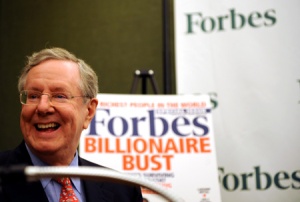Henry Blodget, was once the darling of Wall Street covering Internet securities at Merrill Lynch’s and reporting on businesses such as Infospace, Internet Capital Group and Amazon. In 2002 Blodget’s salary was $12 million. He was the industry’s sound bite on all things tech until New York Attorney General, Eliot Spitzer singled him out as the poster boy for everything that was wrong with Wall Street. This was in direct response to the implosion of the tech bubble and the fall out of Enron, Worldcom and the questionable research produced by the investment banks in general and Blodget in particular. In 2003 Blodget struck a civil settlement deal with the SEC that cost him $4 million. Blodget also agreed never to work on the Street again.
Today Blodget is running one of the most successful financial online magazines, Business Insider. Blodget was hand picked by BI’s founder Kevin Ryan who was also the founder of Double Click. BI has over 9 million readers and a good deal more than that if you include its international following. The site also has the backing of some prominent technology investors including Jeff Bezos the founder and CEO of Amazon, who just sunk $5 million into company and joins the likes of Mark Andreesen and Allen and Company as co-investors. The Bezos investment brings Blodget full circle as it was Blodget’s prediction that Amazon would be worth more than $400 a share back in 1998 that prompted Merrill Lynch to hire him as their Internet analyst, when Amazon’s stock shot up more than 128% a little over a month after Blodget made the prediction.
Recently Ken Auletta wrote an in-depth seven-page article in the New Yorker on Blodget pre-empting what some are surmising is a move back Wall Street. Blodget’s story provides a great insight into the changing landscape of the three world’s that intersect at Blodget’s desk: financial analysis, on-line magazines and journalism.
The story of Blodget, as it was featured in the New Yorker, caught my attention as Blodget first came into prominence around the time that I entered the venture industry. In fact, one of the companies that Blodget covered as an analyst, GoTo.com, was a Kline Hawkes’ investment and was sited by Spitzer as an example of the fraudulent collusion that existed between Merrill’s research analysts and its investment banking division. In 2001 GoTo.com the pioneer of paid search and the pay per click model was looking to raise more money in a secondary offering and was considering Merrill Lynch as one of the underwriters. Ultimately GoTo.com went with Credit Suisse First Boston, Salomon Smith Barney and U.S. Bancorp Piper Jaffray at which point Blodget switched his rating on the stock from a Buy to Neutral. This sudden shift in opinion and others like it were deemed fraudulent by the SEC and ultimately cost Blodget his job. It didn’t however prevent GoTo.com from raising approximately $142 million in the offering.
Today Blodget is focused more on attracting eyeballs to his site than banking fees for a multi-billion dollar Wall Street firm. He bangs out about five posts a day and dispatches over 20 tweets from Business Insider’s thirteenth floor Park Avenue South office. Ken Auletta describes BI as being like the illegitimate offspring if Bloomberg and Fleshbot were ever to have a baby. To accommodate BI’s readership of mostly male, upwardly mobile readers the site promotes a tinge of raunch to it’s news stories along with coverage of the markets and insights into how to make money from the Internet. The stories are punchy and up to the minute taking advantage of the 24/7 news cycle, linking to other breaking news and churning the stories for BI’s own benefit in a in a fleshed out “re-tweet” fashion. Photos dominate throughout, attracting your eye to the next delicious tidbit.
The average reader is on the site for approximately four minutes. Given that the average reader can take in between 200 hundred to 250 words, that represents an 800 to 1000 word article or more likely a brief scan of a couple of articles that have caught your attention because of BI’s heavy use of photos. Blodget says that “the key difference” between judging companies on Wall Street and in journalism “is that, on Wall Street, I was viewed as a financial adviser.” Online, he said, he neither makes recommendations nor offers financial advice.”
Despite its popularity BI made a loss last year of $3 million and projects to generate approximately $11 million in revenues in 2012, or just one million dollars less than Blodget’s salary more than ten years ago, which just goes to show how difficult it is to make money as a journalist these days. BI board member, Gordon Crovitz noted in The New Yorker story, “We’ve gone from an era when people were afraid that journalism would disappear to an era when the question is: What are the new business models that will support it?” Which also suggest that BI is still searching for theirs or at least are trying to prove that their model can scale.
Auletta wraps up his piece with a Blodget Mea Culpa and a hint at what might be in store for the restless and some might say reckless stock promoter. “I love what I’m doing and I think it’s unlikely that I would ever work on Wall Street again, even if it were up to me.” Ten years ago “I got what amounted to a dishonorable discharge from the industry, and I’ve always been ashamed of that. At some point, if it seems appropriate, I would like to explore the possibility of being reinstated.” Certainly if Blodget could begin to benefit from his insider status and be paid for stock picking foresights it would bolster the fortunes of BI and its investors. As Steve Forbes once told me “You make more money providing financial advice than you do listening to it.”


